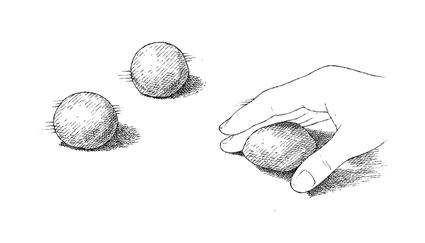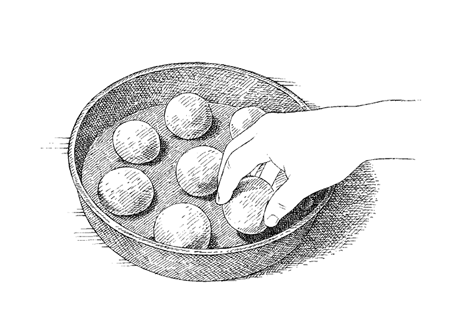The Cook's Illustrated Cookbook (279 page)
Read The Cook's Illustrated Cookbook Online
Authors: The Editors at America's Test Kitchen
Tags: #Cooking

MAKES 16 ROLLS
If you don’t have a stand mixer, you can mix the dough by hand following the instructions in
“TEST KITCHEN TIP NO. 119 HAND-MIXING METHOD FOR DOUGH”
. Because this dough is sticky, keep your hands well floured when handling it.
1¹⁄ | cups plus 1 tablespoon water, room temperature |
2 | teaspoons honey |
1¹⁄ | teaspoons instant or rapid-rise yeast |
3 | cups plus 1 tablespoon (16¹⁄ |
3 | tablespoons whole wheat flour |
1¹⁄ | teaspoons salt |
1.
Whisk water, honey, and yeast together in bowl of stand mixer until well combined, making sure no honey sticks to bottom of bowl. Transfer bowl to stand mixer fitted with dough hook. Add flours and mix on low speed until cohesive dough is formed, about 3 minutes; cover bowl tightly with plastic wrap and let sit at room temperature for 30 minutes.
2.
Sprinkle salt evenly over dough and knead on low speed for 5 minutes, scraping down bowl and dough hook as needed. Increase speed to medium and continue to knead until dough is smooth and slightly tacky, about 1 minute. If dough is very sticky, add 1 to 2 tablespoons flour and continue mixing for 1 minute. Transfer dough to large, lightly greased bowl; cover tightly with plastic and let rise at room temperature until doubled in size, about 1 hour.
3.
Spray rubber spatula or bowl scraper with vegetable oil spray. Fold partially risen dough over itself by gently lifting and folding edge of dough toward middle. Turn bowl 90 degrees; fold again. Rotate the bowl again and fold once more. Cover with plastic and let rise for 30 minutes. Repeat folding, replace plastic, and let dough rise until doubled in size, about 30 minutes longer.
4.
Grease two 9-inch round cake pans. Transfer dough to floured counter and sprinkle top with more flour. Using bench scraper, cut dough in half and gently stretch each half into 16-inch log. Cut each log into 16 equal pieces and dust top of each piece with more flour. With floured hands, gently pick up each piece and roll in palms to coat with flour, shaking off excess. Arrange rolls in prepared pans, placing one in center and seven spaced evenly around edges, with long side of each roll running from center of pan to edge and making sure cut side faces up. Loosely cover pans with lightly greased plastic and let rolls rise until doubled in size, about 30 minutes. (Dough should barely spring back when poked with knuckle.)
5.
Thirty minutes before baking, adjust oven rack to middle position and heat oven to 500 degrees. Spray rolls lightly with water, bake until tops of rolls are brown, about 10 minutes, then remove them from oven. Reduce oven temperature to 400 degrees; using kitchen towels or oven mitts, invert rolls from both cake pans onto rimmed baking sheet. When rolls are cool enough to handle, turn them right side up, pull apart, and space evenly on baking sheet. Continue to bake until rolls develop deep golden brown crust and sound hollow when tapped on bottom, 10 to 15 minutes, rotating baking sheet halfway through baking. Transfer rolls to wire rack and let cool to room temperature, about 1 hour, before serving. (Rolls can be placed in zipper-lock bag and stored at room temperature for up to 3 days. Wrapped with aluminum foil before placing in bag, rolls can be frozen for up to 1 month. To recrisp the crust, thaw rolls at room temperature, if frozen, and place unwrapped rolls in 450-degree oven for 6 to 8 minutes.)
![]() WHY THIS RECIPE WORKS
WHY THIS RECIPE WORKS
Quick recipes for dinner rolls produce rolls that aren’t much better than what you buy at the supermarket because they don’t allow enough time for the dough to develop much flavor. But homemade rolls—made right—are often too bothersome for an overextended home cook. We wanted to develop a largely make-ahead recipe that would deliver rich, soft, tender, airy, semisweet, pull-apart all-American dinner rolls. We started by getting the ingredients just right. Plenty of butter contributed richness; an additional egg gave the rolls more flavor and better texture; and scalded milk made the rolls soft, tender, and rich. For ideas about the best technique, we turned to the queen mother of rich breads: brioche. Traditionally, brioche undergoes several rises, including a slow, cool rise in the fridge that gives the flavors time to develop. The same magic worked on our rolls. This technique also had the advantage of allowing the bulk of the work to be completed a day (or even two days) in advance.
See “SHAPING DINNER ROLLS” illustrations that follow recipe.
MAKES 16 ROLLS
If you don’t have a stand mixer, you can mix the dough by hand following the instructions in
“TEST KITCHEN TIP NO. 119 HAND-MIXING METHOD FOR DOUGH”
. For this recipe, the dough is made and the rolls are shaped and refrigerated a day or two before being baked and served. Be sure to plan accordingly, as the refrigerated rolls require about 6 hours to rise before they’re ready for baking. If your cake pans have a dark nonstick finish, bake the rolls in a 375-degree oven to moderate the browning. This dough should be moister than most; resist the urge to add more flour than is needed to keep the dough from sticking to your hands. Made on a humid day, the dough may require more flour than if made on a dry day.
³⁄ | cup whole milk |
8 | tablespoons unsalted butter, melted |
6 | tablespoons sugar |
1¹⁄ | teaspoons salt |
2 | large eggs, room temperature |
2¹⁄ | teaspoons instant or rapid-rise yeast |
3 | cups (15 ounces) all-purpose flour, plus extra as needed |
1.
Bring milk to boil in small saucepan over medium heat; let stand off heat until skin forms on surface, 3 to 5 minutes. Remove and discard skin from surface using spoon. Transfer milk to bowl of stand mixer and add 6 tablespoons melted butter, sugar, and salt; whisk to combine and let mixture cool. When mixture is just warm to touch (90 to 100 degrees), whisk in eggs and yeast until combined.
2.
Place bowl on stand mixer fitted with dough hook, add flour, and mix on low speed until combined, 1 to 2 minutes. Increase speed to medium-low and knead about 3 minutes; when pressed with finger, dough should feel tacky and moist but should not stick to finger. (If dough is sticky, add another 1 to 3 tablespoons flour.) Continue to knead until cohesive, elastic dough has formed (it should clear sides of bowl but stick to bottom), 4 to 5 minutes longer. Transfer dough to lightly floured counter and knead by hand until very soft and moist but not overly sticky, 1 to 2 minutes. (If dough sticks excessively to hands and work surface, knead in flour 1 tablespoon at a time until dough is workable.) Place dough in large, lightly greased bowl; cover tightly with plastic wrap and let rise at room temperature until doubled in size, 2 to 3 hours.
3.
Grease two 9-inch round cake pans. Transfer dough to lightly floured counter and press into rough 12 by 10-inch rectangle, with long side facing you. Roll dough toward you into firm cylinder, keeping roll taut by tucking it under itself as you go. Using palms, roll dough (seam side down) from center outward until cylinder measures 18 inches. Using bench scraper, cut cylinder into 16 equal pieces. Working with 1 piece of dough at a time, loosely cup hand around dough (not directly over it) and, without applying pressure, move hand in small circular motions to form smooth, taut round. Arrange shaped rolls in prepared pans (one in center and seven spaced evenly around edges); loosely cover cake pans with lightly greased plastic, then cover pans securely with foil. Refrigerate for at least 24 or up to 48 hours.
4.
Remove foil (but not plastic) from cake pans; let rolls rise at cool room temperature until doubled in size (rolls should press against each other), 6 to 7 hours. Thirty minutes before baking, adjust oven rack to lower-middle position and heat oven to 400 degrees. Brush rolls with remaining 2 tablespoons melted butter and bake until deep golden brown, 14 to 18 minutes. Let rolls cool in pans on wire rack for about 3 minutes, then invert onto rack; re-invert rolls and let cool for 10 to 15 minutes longer. Break rolls apart and serve warm. (Rolls can be placed in zipper-lock bag and stored at room temperature for up to 3 days. Wrapped with aluminum foil before placing in bag, rolls can be frozen for up to 1 month.)

1.
After patting dough into 12 by 10-inch rectangle, roll dough to form even cylinder, stretching to 18-inch length.

2.
Using bench scraper or chef’s knife, cut cylinder into 16 pieces.

3.
Using circular motion, gently form dough pieces into rounds. (Tackiness of dough against counter and circular motion should work dough into smooth, even ball.)

4.
Arrange rolls in pan, one in center, seven around edge.
